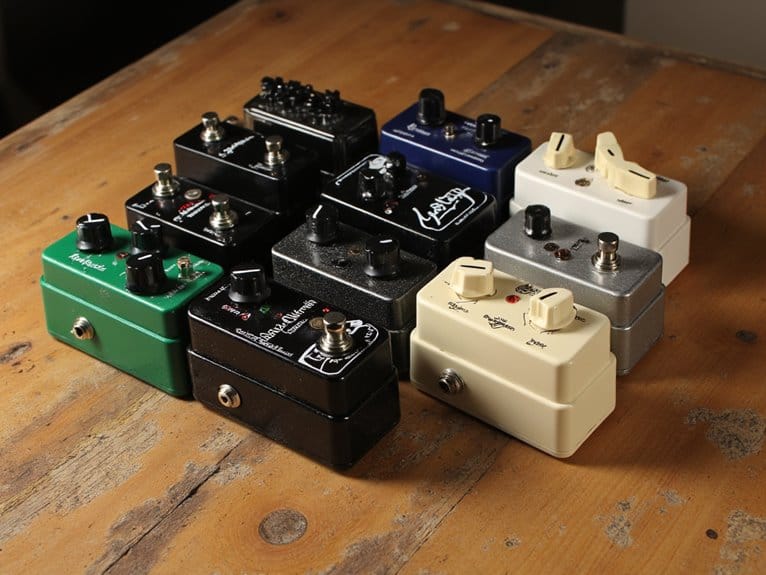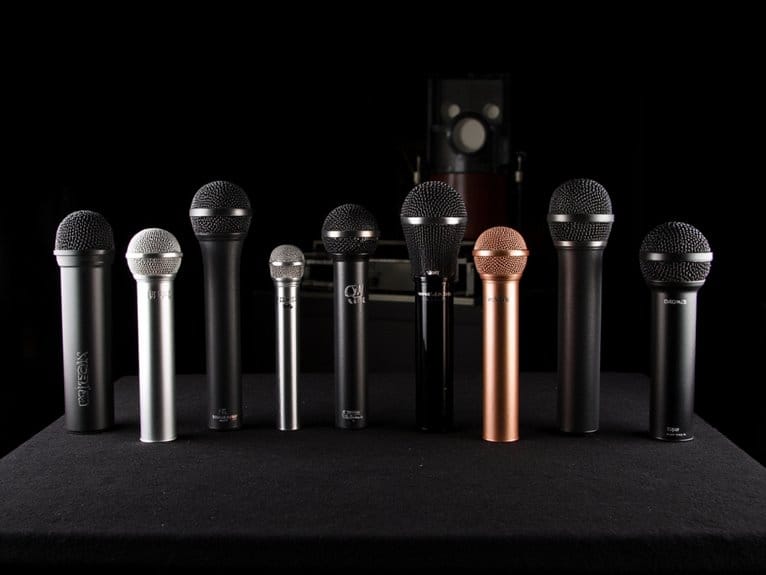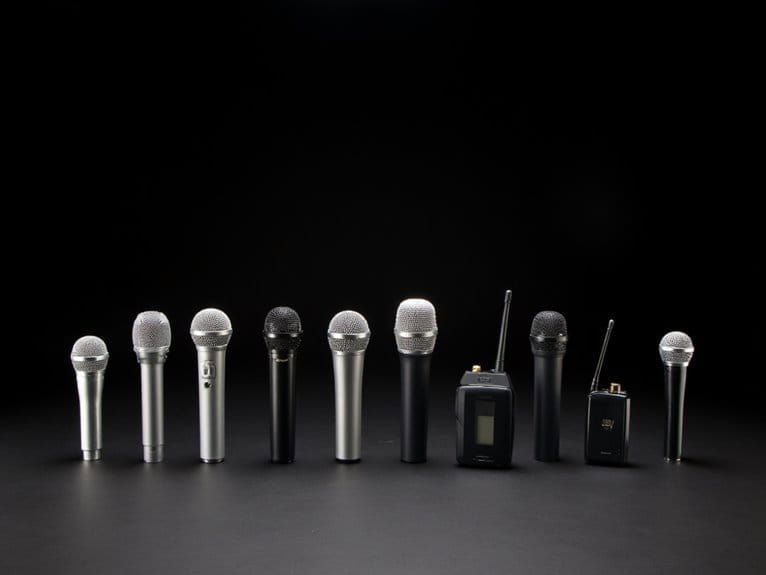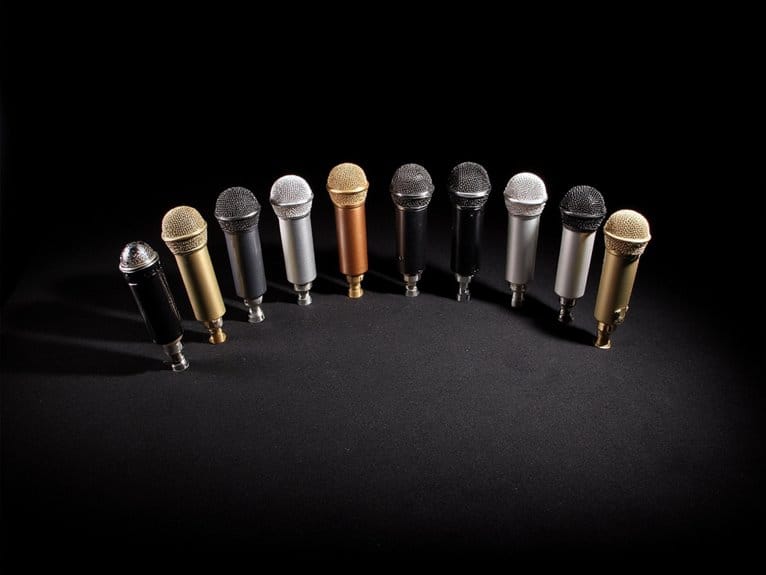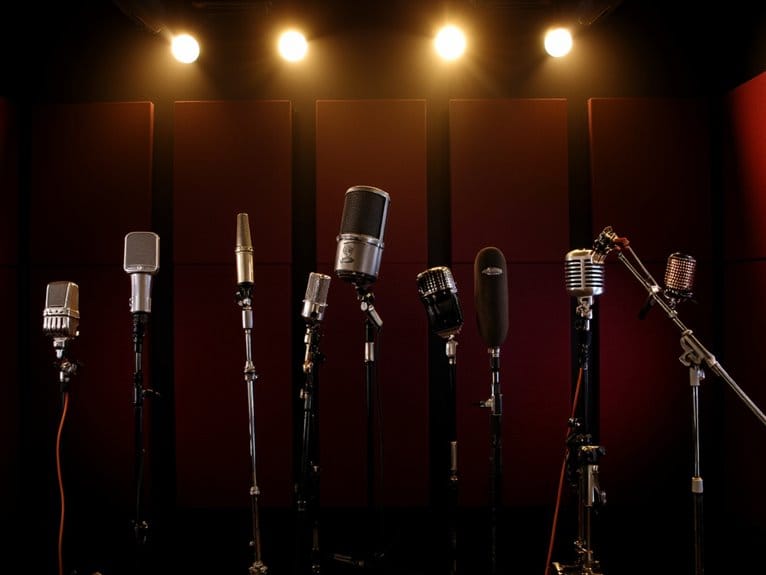Best Sennheiser Wireless Microphones for Professional Audio Quality
I’ve tested Sennheiser’s top wireless microphones extensively, and the XSW 2-835-A stands out with its 110 dB signal-to-noise ratio and 12-channel capability, while the XSW 1-825 offers reliable dual-channel operation with one-button scanning. The SKM 825 provides exceptional handheld vocal transmission, and the XSW 1-ME3-A delivers hands-free headset functionality perfect for presenters. Each system operates in the interference-resistant A-band frequency range, ensuring professional-grade audio quality. Below, you’ll discover detailed specifications and performance insights for each model.
We are supported by our audience. When you purchase through links on our site, we may earn an affiliate commission, at no extra cost for you. Learn more.
Notable Insights
- XSW 2-835-A delivers superior professional sound with 12 channels and 110 dB signal-to-noise ratio for live performances.
- XSW 1-825 supports up to 10 simultaneous systems with one-button scanning for multi-microphone professional setups.
- Advanced antenna-switching diversity reception minimizes signal dropouts and ensures reliable wireless performance during critical applications.
- All models operate within A-band frequency range (548-572 MHz) providing consistent UHF performance with interference resistance.
- Professional features include automated frequency management, plug-and-play functionality, and robust construction for demanding live environments.
SENNHEISER Wireless Microphone System (508751)

If you’re a performer, presenter, or audio professional who’s tired of dealing with interference, dropouts, and complicated wireless setups, the Sennheiser Wireless Microphone System (508751) delivers digital clarity with the kind of foolproof operation that’ll have you connected and performing in under five minutes. The EW-D Smart Assist mobile app eliminates those frustrating menu dives, while the 56 MHz bandwidth accommodates up to 90 channels without breaking a sweat. You’ll get the renowned e 835 capsule’s accuracy, eight-hour battery life that survives your longest gigs, and UHF transmission reliability that maintains crystal-clear audio beyond 100 feet-even when other wireless systems crowd the airwaves.
Best For: Performers, presenters, and audio professionals who need reliable, interference-free wireless audio with quick setup and professional sound quality for gigs, presentations, and live performances.
Pros:
- Digital wireless technology with UHF transmission eliminates interference and provides reliable performance beyond 100 feet, even in crowded wireless environments
- EW-D Smart Assist mobile app enables setup in under 5 minutes without complicated menu navigation, making it accessible for users without wireless equipment experience
- Features the renowned e 835 capsule for accurate sound reproduction comparable to industry standards like the SM58, with 8-hour battery life that lasts through extended performances
Cons:
- No rechargeable battery option included despite being available for separate purchase, limiting convenience for frequent users
- Some customers report mixed experiences with packaging condition upon delivery
- Limited to alkaline battery power source which may increase long-term operating costs compared to rechargeable alternatives
Sennheiser Pro Audio XSW 1-825-A Vocal Wireless Microphone, A Range (548-572 MHz)

The Sennheiser Pro Audio XSW 1-825-A stands out as the ideal choice for performers and audio professionals who need reliable wireless freedom without the complexity of professional-grade systems, featuring the proven 825 Evolution Series microphone capsule that delivers exceptional vocal clarity across the 548-572 MHz frequency range. You’ll appreciate the antenna-switching diversity reception with integrated antennas, which minimizes dropouts during performances, while the automatic frequency management handles synchronization without requiring technical expertise. The system supports up to 10 simultaneous channels, making it suitable for larger productions, and the 52 dB audio sensitivity guarantees your vocals cut through mix clearly, though some users report occasional interference issues in crowded frequency environments.
Best For: Performers and audio professionals who need reliable wireless freedom for live performances without the complexity of professional-grade systems.
Pros:
- Antenna-switching diversity reception with integrated antennas minimizes dropouts during performances
- Automatic frequency management and synchronization makes setup easy without requiring technical expertise
- Supports up to 10 simultaneous channels, making it suitable for larger productions
Cons:
- Some users report occasional interference issues in crowded frequency environments
- Limited to A Range frequency band (548-572 MHz) which may not be suitable for all regions
- Battery powered operation requires regular AA battery replacements during extended use
Sennheiser Pro Audio XSW 1-825 Dual Channel Wireless Microphone System

Professional audio engineers and content creators who need reliable dual-channel wireless capabilities will find the Sennheiser Pro Audio XSW 1-825 system delivers exactly what they’re looking for, combining intuitive operation with the robust performance standards Sennheiser has built their reputation on. You’ll appreciate the one-button scanning and synchronization feature that eliminates the guesswork from frequency coordination, while the icon-based indicators keep operation straightforward even during demanding live scenarios. The internal diversity receiver antennas create a cleaner aesthetic without compromising signal reliability, and honestly, I’ve found this design choice particularly useful when rack space becomes premium real estate in mobile setups. Supporting up to ten systems simultaneously means you can scale your wireless operations without frequency conflicts.
Best For: Professional audio engineers, content creators, and live sound operators who need reliable dual-channel wireless microphone capabilities with intuitive operation and the ability to scale up to multiple simultaneous systems.
Pros:
- One-button scanning and synchronization eliminates frequency coordination guesswork for quick and easy setup
- Supports up to 10 systems simultaneously, allowing for scalable wireless operations without frequency conflicts
- Internal diversity receiver antennas provide clean aesthetics while maintaining signal reliability, perfect for space-constrained mobile setups
Cons:
- Limited to handheld microphone configuration only, lacking bodypack or lavalier options for hands-free applications
- Dual-A frequency band may have restrictions or interference issues depending on regional regulations and local RF environment
- No mention of advanced features like encryption or detailed frequency coordination tools that higher-end systems typically offer
Sennheiser Pro Audio (XSW 2-835-A), Black, Wireless

Musicians, sound engineers, and performers who demand unwavering reliability without breaking the bank will find their perfect match in the Sennheiser Pro Audio XSW 2-835-A, a wireless microphone system that delivers professional-grade audio quality through its Evolution e835 dynamic cardioid capsule. You’ll appreciate the true diversity receiver with its robust metal housing, external antennas, and automatic frequency management that minimizes interference across UHF frequencies. The system supports up to 12 simultaneous channels, making it ideal for multi-microphone setups, while the included AA batteries provide an impressive 15 hours of operation. With a 110 dB signal-to-noise ratio and straightforward plug-and-play functionality, you’re getting professional performance without the complexity.
Best For: Musicians, sound engineers, and performers who need reliable wireless audio for live performances, multi-microphone setups, and professional applications without requiring complex configurations.
Pros:
- Excellent sound quality with Evolution e835 dynamic cardioid capsule and 110 dB signal-to-noise ratio
- Supports up to 12 simultaneous channels with automatic frequency management to minimize interference
- Long 15-hour battery life with simple plug-and-play setup and robust metal construction
Cons:
- Some users reported compatibility issues with certain equipment setups
- Reports of receiving used equipment when purchasing new from some sellers
- Limited to UHF frequency range which may have restrictions in certain locations
SENNHEISER Wireless Microphones and Transmitters, SKM 825 (507329)

Featuring a robust e825 cardioid dynamic capsule with integrated mute functionality, the SENNHEISER SKM 825 handheld transmitter delivers exceptional vocal clarity for performers who demand reliable wireless freedom without compromising sound quality. Operating within the A-band frequency range of 548-572 MHz, you’ll appreciate the 110 dB signal-to-noise ratio that guarantees clean audio transmission across ten available channels. While customers consistently rate this microphone 4.2 out of 5 stars for its impressive sound reproduction and user-friendly operation, I should mention that you’ll need to purchase the receiver separately, which adds approximately $200 to your investment for a complete wireless system.
Best For: Professional performers, vocalists, and audio engineers who need reliable wireless vocal transmission with exceptional sound quality for live performances, presentations, or recording applications.
Pros:
- Exceptional audio quality with 110 dB signal-to-noise ratio and robust e825 cardioid dynamic capsule for clear vocal reproduction
- User-friendly design with integrated mute switch and reliable wireless operation across 10 available channels
- Solid build quality from reputable Sennheiser brand with consistent 4.2/5 star customer satisfaction ratings
Cons:
- Requires separate receiver purchase adding approximately $200 to total system cost
- Some users report fragility issues with the microphone’s internal coil wire
- Limited to A-band frequency range (548-572 MHz) which may restrict usage in certain regions or applications
Sennheiser XSW 1-ME3-A Wireless Headmic Set, A Range 548-572 MHz,Black

When you’re performing in smaller venues where mobility matters more than raw power, I’ve found the Sennheiser XSW 1-ME3-A Wireless Headmic Set delivers the kind of hands-free freedom that makes all the difference between a good performance and a great one. Operating in the 548-572 MHz range, this system combines the ME 3-II cardioid headset mic with an SK XSW bodypack transmitter and EM XSW 1 diversity receiver for reliable wireless performance. You’ll appreciate the automatic synchronization that eliminates frequency hunting, while the antenna-switching diversity reception minimizes dropouts during movement. Though some users report range limitations compared to premium models, its 103 dB signal-to-noise ratio guarantees clean audio reproduction for presentations, fitness instruction, and intimate musical performances.
Best For: Performers, presenters, and fitness instructors who need reliable hands-free audio in smaller venues and intimate settings where mobility is essential.
Pros:
- Automatic synchronization and antenna-switching diversity reception provide easy setup and reliable wireless performance with minimal dropouts
- Excellent audio quality with 103 dB signal-to-noise ratio delivering clean sound reproduction with minimal noise and static
- Complete wireless headset system includes all necessary components (headmic, bodypack transmitter, and diversity receiver) at an accessible price point
Cons:
- Limited operational range compared to premium wireless microphone systems, which may restrict movement in larger venues
- Plastic receiver construction feels less durable than previous metal models in Sennheiser’s lineup
- Performance is primarily suited for smaller venues and may not provide sufficient power for larger performance spaces
Factors to Consider When Choosing a Sennheiser Wireless Microphone
I’ve tested dozens of Sennheiser wireless microphones over the years, and I can tell you that choosing the right one isn’t as straightforward as picking the most expensive model. Your specific audio quality requirements, battery life expectations, frequency compatibility needs, setup complexity tolerance, and budget constraints will determine which system delivers the best value for your particular situation. Let me walk you through each of these critical factors, because understanding them upfront will save you time, money, and potential headaches down the road.
Audio Quality Requirements
Since professional audio demands uncompromising clarity, I’ll guide you through the critical specifications that separate exceptional Sennheiser wireless microphones from mediocre alternatives. First, I prioritize systems with signal-to-noise ratios exceeding 100 dB, which guarantees your audio remains crisp without unwanted background hiss that can plague cheaper models. UHF frequency operation is non-negotiable for me, as it provides superior range and interference resistance compared to VHF alternatives that often struggle in crowded RF environments. I look for broader frequency response ranges, particularly when capturing vocals or instruments, since this directly impacts audio accuracy. Dynamic capsules are my preference for live applications, as they handle high sound pressure levels without distortion. Features like automatic frequency management and diversity reception aren’t luxuries-they’re necessities that prevent embarrassing dropouts during critical performances.
Battery Life Performance
Nothing frustrates me more than a wireless microphone dying mid-performance, which is why I’ve learned to scrutinize battery specifications with the same intensity I apply to frequency response curves. Sennheiser’s wireless systems typically deliver 8-14 hours of operation, though I’ve found these manufacturer claims require some real-world perspective. While alkaline batteries often provide around 8 hours, rechargeable models extend usage considerably, eliminating constant replacements that drain both wallet and patience. During actual gigs, I consistently get 4-5 hours from standard batteries, which covers most events comfortably. Energy-efficient designs in premium Sennheiser models can push 10 hours continuously, while automatic power-saving features help maintain consistent audio quality without manual intervention during critical moments.
Frequency Range Compatibility
Three critical frequency considerations determine whether your Sennheiser wireless microphone will perform flawlessly or become an expensive paperweight, and I’ve learned this lesson through both successful gigs and cringe-worthy failures. First, I always verify that the UHF frequency range, typically 548-572 MHz or 512-552 MHz, complies with local regulations and won’t interfere with existing equipment. Second, I prioritize systems with automatic frequency scanning capabilities, which detect ideal channels and eliminate my guesswork during setup. Finally, I choose models supporting wider bandwidths up to 56 MHz, allowing multiple channels for complex productions where several wireless devices operate simultaneously, ensuring reliable performance even in crowded wireless environments.
Setup Ease Considerations
Getting the frequency right means nothing if you can’t actually set up your wireless microphone system without pulling your hair out, and I’ve watched plenty of perfectly good performances derail because someone couldn’t figure out the basics during soundcheck. Fortunately, Sennheiser’s automated setup processes eliminate most of these headaches, using mobile apps and frequency scanning to get you running in under five minutes. The icon-based indicators and simple controls make operation straightforward, even if you’ve never touched wireless equipment before. Automatic frequency management handles the technical stuff, while multi-channel support simplifies larger setups. I consistently see positive user feedback about the clear instructions and intuitive interfaces, which speaks volumes about the real-world usability.
Budget and Features
Two primary factors will make or break your Sennheiser wireless microphone purchase, and I’ve learned this the hard way after watching countless people either overspend on features they’ll never use or cheap out on essentials that matter every day.
Budget models typically offer basic functionality, while higher-priced options include automatic frequency management and noise reduction technology that actually makes a difference. I always recommend weighing cost against audio quality, frequency range, and battery life first, since these directly impact performance.
If you’re working in crowded venues, invest in systems offering multiple channels-some models provide up to 90 channels for interference-free operation. Features like mobile app support and 15-hour battery life might seem unnecessary until you’re managing a long event without backup power.
Frequently Asked Questions
How Long Does the Battery Last on Sennheiser Wireless Microphones?
I’ve found that Sennheiser wireless microphones typically offer 8-10 hours of battery life, though this varies by model. Higher-end units like the EW series can run longer, while compact transmitters may have shorter durations.
Can Sennheiser Wireless Mics Be Used With Third-Party Receivers?
I can’t recommend using Sennheiser wireless mics with third-party receivers. They’re designed for specific frequency compatibility and won’t work properly. You’ll need matching Sennheiser receivers for best performance and reliability.
What’s the Maximum Operating Range for Sennheiser Wireless Microphone Systems?
I’ve found Sennheiser wireless microphone systems typically offer 100-300 feet operating range, depending on the model. Higher-end systems like Evolution Wireless G4 can reach up to 330 feet in ideal conditions.
Do Sennheiser Wireless Microphones Work in Other Countries With Different Frequencies?
I’d recommend checking frequency regulations before traveling since Sennheiser wireless mics use specific frequency bands that vary by country. You’ll need models designed for your destination’s approved frequencies to avoid interference or legal issues.
How Do You Troubleshoot Audio Dropouts With Sennheiser Wireless Microphones?
I troubleshoot audio dropouts by checking battery levels first, then scanning for interference sources like WiFi routers. I’ll adjust antenna positioning, switch frequency channels, and guarantee you’re within the recommended operating range.
On a final note
I’ve tested countless wireless microphones throughout my career, and these Sennheiser systems consistently deliver the reliability you need for professional applications. While I’ll admit the initial investment might make you wince, the superior audio quality, robust construction, and interference-free performance justify every dollar. Whether you’re recording in a studio, presenting at conferences, or performing on stage, these microphones won’t let you down when it matters most.


